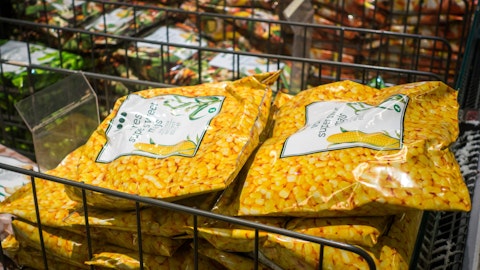Sysco Corporation (NYSE:SYY) Q1 2024 Earnings Call Transcript October 31, 2023
Operator: Welcome to Sysco’s First Quarter Fiscal Year 2024 Conference Call. As a reminder, today’s call is being recorded. We will begin with opening remarks and introductions. I would like to turn the call over to Kevin Kim, Vice President of Investor Relations. Please go ahead.
Kevin Kim: Good morning, everyone, and welcome to Sysco’s first quarter fiscal year 2024 earnings call. On today’s call, we have Kevin Hourican, our President and CEO; and Kenny Cheung, our CFO. Before we begin, please note that statements made during this presentation that state the company’s or management’s intentions, beliefs, expectations or predictions of the future are forward-looking statements within the meaning of the Private Securities Litigation Reform Act, and actual results could differ in a material manner. Additional information about factors that could cause results to differ from those in the forward-looking statements is contained in the company’s SEC filings. This includes, but is not limited to, risk factors contained in our annual report on Form 10-K for the year ended July 1, 2023, subsequent SEC filings and the news release issued earlier this morning.

A friendly grocery store team stocking shelves with foodservice products.
A copy of these materials can be found in the Investors section at sysco.com. Non-GAAP financial measures are included in our comments today and our presentation slides. The reconciliation of these non-GAAP measures to the corresponding GAAP measures is included at the end of the presentation slides and can also be found in the Investors section of our Web site. During the discussion today, unless otherwise stated, all results are compared to the same quarter in the prior year. To ensure we have sufficient time to answer all questions, we’d like to ask each participant to limit their time today to one question and one follow up. At this time, I’d like to turn the call over to Kevin Hourican.
Kevin Hourican: Thank you, Kevin, and good morning, everyone. Thank you for joining our call today. Our prepared remarks will cover the following themes; competence in reiterating fiscal year ’24 guidance, another record quarter of disciplined financial performance with a focus on profitable growth, disciplined ROIC and balanced capital allocation priorities. These themes all confirmed Sysco’s strength as the market leader. During our call today, I plan to cover two topics. First, a summary of our Q1 results; and second, a spotlight on our Recipe for Growth strategy and how we continue to build capabilities for profitable growth at Sysco. So let’s get started on Slide 5. Our positive momentum from last year continued with tops and bottom line growth in Q1 to kick off the new fiscal year.
Beginning with the top line, we delivered sales growth of 2.6% driven by a combination of positive case volume growth and effective management of product costs deflation in the U.S. Turning to the bottom line, we posted double digit growth in both adjusted operating income and adjusted EPS, with an adjusted earnings per share of $1.07. We delivered this double digit bottom line growth in a slowing top line macro and deflationary COGS pressure within the U.S. Our ability to post strong results in Q1, considering those factors, is a proof point that Sysco is positioned to be successful in fiscal ’24. We believe the breadth and quality of our product assortment across both broadline and specialty, combined with the expertise of our commercial selling organization, and the strength of our supply chain and balance sheet positions Sysco to produce compelling results in the near term, and even stronger results over the longer term.
Digging a bit deeper into the quarter, we grew volumes in our U.S. Foodservice segment, with Q1 total case volume growth of 1.6% and local case volume essentially flat year-over-year. We successfully grew share, as the industry was roughly flat for the quarter. Our national sales team posted an outstanding quarter, winning substantial new business in the healthcare, restaurant and hospitality sectors. As I have stated before, we are winning these multiyear contracts with strong profit profiles versus historical averages. Our success is a testament to the improvements we have made and how we serve large national customers. We have made it easier for national customers to do business with Sysco by improving our technology integration with our customers’ systems, and by providing large customers with more dedicated and accountable support.
Additionally, our national and international fulfillment scale is very attractive to large concepts. We are able to provide them with supply chain that can scale with them wherever they operate. We expect our national sales segment to continue to outpace the industry due to these capabilities. Our local performance continues to outpace the overall industry, building on a positive multiyear trend. The local market has slowed quarter-over-quarter and Sysco is not reacting by leading with price to win share. Instead, we are focused on profitable growth, properly serving our local customers and improving our local sales execution. Local volume, as I said, was essentially flat and that is something we intend to improve upon in our year-to-go periods.
We’re taking the following actions to drive increased growth in local volumes. First, we will invest in incremental sales headcount as we have grown our local business faster than the overall industry for each of the past three years. Our territory sizes for the sales teams have increased as well. We are actively hiring more sales resources, which will allow us to optimize territory sizes and enhance sales consultant effectiveness. The benefits from increasing our local sales force will accrue over time as new colleagues complete training and settle into their territories. We expect to see the majority of the positive impact from this action in fiscal year ’25. Second, we recently enhanced the compensation model for our sales consultants to incentivize our colleagues to focus on profitably growing their and Sysco’s business.
This change was implemented recently during our fiscal Q2, and the positive effects will be felt in future quarters of this fiscal year. The change to our compensation model better aligns the incentives of our sales team to the key priorities of Sysco. Third, we recently ramped up our focus on what we call visit frequency and visit quality expectations. Through our robust CRM, we are able to track the activity and outcomes from our sales team. Our sales leadership team is focused on colleague coaching to improve outcomes on both fronts. Lastly, total team selling which was recently expanded coast to coast will improve cross-selling opportunities, combining the relationship strength of our sales consultants with the product expertise of our specialty businesses.
All told, we are confident we can increase local sales volume growth, while maintaining momentum with strong margin management. We will drive that improvement through healthy long-term decisions and by remaining disciplined in our pricing decisions. Next, I would like to provide a brief summary of select Recipe for Growth enhancements from our recent quarter. We recently implemented a global operating model for our leadership structure. It is important to note that our international segment posted another strong performance in Q1, solidly growing top line and bottom line faster than the U.S. business. The change to the global operating model will help further accelerate our progress internationally. We will move faster in adopting best practices, delivery of new capabilities, and leveraging new tools across Sysco’s global footprint.
An example would be taking the Sysco Your Way concept and bringing it to life globally. To head this new operating model, we named Greg Bertrand our Global Chief Operating Officer. In his expanded role, Greg will be accountable for managing Sysco’s global operations, driving profitable growth in local sales and operations. I’m extremely confident in Greg as a leader and I’m bullish on the impact that he will have on his expanded geographic territory. We continue to make progress in improving the performance of our supply chain. Chart 10 displays our year-over-year operating profit improvement driven by a positive operating leverage with gross profits growing at a faster rate than operating expenses. Our supply chain operation remains fully staffed, and we continue to improve employee retention and we’re building on productivity gains.
We recently implemented a new and improved labor scheduling tool that has increased our flexibility in matching our staffing to the variable work nature of our business. As a result, we’re becoming more flexible in how we manage our cost structure to match business volume seasonality. The end result of that improvement is a lower cost structure. In addition to our focus on improving current day supply chain performance, we’re expanding our supply chain capacity to increase our ability to serve rapidly growing markets. For example, we recently celebrated the groundbreaking for a net new Sysco fold-out site in Mesa, Arizona. Each new fulfillment center at Sysco undergoes a vigorous ROIC review, and a project prioritization test. Each of the investments will increase our capacity and feed future Sysco growth in already successful high growth geographies.
We are excited to have the first of these net new buildings in Allentown, Pennsylvania opening later this fiscal year. The Allentown facility will enable us to better serve the highly dense northeast corridor and support the eventual expansion of our specialty platforms in that geography. On October 11, we announced an exciting addition to the Sysco family to our planned acquisition of Edward Don, a leading distributor of food service equipment and supplies based out of Chicago. Founded in 1921 and led by Steve Don, the business generates approximately 1.3 billion in annual revenue and services a broad range of customers across the U.S. We believe the acquisition will be a great addition to the Sysco family, further demonstrating our Recipe for Growth strategy but focusing on building strategic specialty platforms that help us support restaurant and hospitality customers.
Every Sysco customer needs restaurant equipment and supplies to manage their business. Don’s compelling product offering and robust supply chain capabilities will improve how we serve those customers. After deal closing, Steve Don will continue to lead the business and we will partner together to profitably grow the segment. Most compelling is the following. Sysco sells to hundreds of thousands of customers who are not currently buying restaurant equipment and supplies from either Don or from Sysco. Post the old approval and closure, we have a great opportunity to introduce the Don assortment to Sysco’s customers and have a one plus one equals three equation through this accretive acquisition. I look forward to working closely with Steve and his capable leadership team to bring that ambition to life for many years to come.
As a wrap up to my remarks this morning, I’ll summarize with the following. We grew our top and bottom line within the quarter and achieved positive operating leverage with gross profit dollars outpacing operating expenses. The result was more than 10% growth in adjusted EPS. This double digit growth is on top of a strong year in 2023. We are being very prudent in how we manage the business in fiscal ’24. We are closely monitoring the macro environment for signals on customer traffic in the rate of expected inflation this year. We are prepared to take actions to ensure we are successful in the operating conditions presented to our industry. For the full year, we believe Sysco is positioned to succeed growing top line faster than the market and delivering robust bottom line growth.
We have three more quarters to go, and we are focused on delivering our plan. I’ll now turn it over to Kenny, who will provide a detailed review of Q1 performance and select fiscal year ’24 guidance commentary. Kenny, over to you.
Kenny Cheung: Thank you, Kevin, and good morning, everyone. I’m going to build upon Kevin’s commentary with a few additional points. First, we are reiterating our annual guidance for fiscal year ’24. We have momentum, and we’re off to a solid start for the year. Q1 was the highest operating income quarter in Sysco’s history, marking the sixth consecutive period of record quarterly profits. We effectively managed deflation in the U.S. Q1 results included sales and volume growth, adjusted gross profit dollar and margin expansion and discipline operating leverage, all slowing down to adjusted EPS growth of over 10%. Second, our Recipe for Growth strategy is delivering accretive margin value across the U.S. and international segments.
For example, we’ve continued to expand and enhance Sysco Your Way neighborhoods globally. In addition, we successfully closed on our BIX acquisition, a leading produce distributor, and our recently announced plans to acquire Edward Don, which will provide further penetration opportunities. Our strong balance sheet enables options to add acquisitions at opportunistic times, while simultaneously returning cash back to shareholders. Lastly, we are the market leader in a growing industry with leading profit margins. We have diversity across geographies, a broad customer mix and brands, in particular the depth of our Sysco product brand, which sets us apart from the competition and is a position of strength. For example, we were hedged from a deflation in the U.S. as international inflation rates remain positive.
Another example of our strong positioning would be local case performance. While we were essentially flat in the U.S., Canada local volumes were up over 6% adding to our outside international growth. These ingredients and fundamental building blocks are unlocking long-term profitable growth and positioning Sysco to win market share in a growing highly fragmented industry. Now turning to a summary of our reported results for the quarter, starting on Slide 14. For the first quarter, our enterprise sales grew 2.6% with U.S. Foodservice growing 0.9%, international growing 12.2% and SYGMA decreasing 1.4% as we recently exited business that did not meet our discipline profit threshold. This planned exit helped double our SYGMA profits this quarter, another prime example of ROIC in action.
Enterprise inflation was 1.7% and positive throughout the quarter. U.S. broadline inflation was negative 0.4% and our international segment was up double digits in line with our expectations for the first quarter. Total U.S. Foodservice volume increased 1.6% and local volume was essentially flat. We produced $3.6 billion in gross profit, up 4.6% versus the prior year. Adjusted gross margin improved to 18.6%, an increase of 36 bps compared to last year. As mentioned earlier, our gross profit dollar and margin percentage improvement during the first quarter reflected our ability to effectively manage product costs fluctuations. The improvement in gross profit was driven by incremental progress from our strategic sourcing efforts, discipline pricing, as well as improved penetration rates from Sysco brand products, which increased 6 bps to 37.2% in U.S. broadline and 53 bps to 47.5% in U.S. local results.
Overall, adjusted operating expense were $2.8 billion for the quarter or 14.2% of sales. The strong management of expenses during the quarter was due to the positive impact of the variable labor planning tool Kevin mentioned and benefits from our previously announced $100 million of cost-out commitments, which commence at the start of the year. For example, we are expanding the use of shared services in Canada which are expected to drive improved operational efficiencies. These actions items enable Sysco to reduce Q1 adjusted at SG&A at the global support center by approximately 7% year-over-year. All four operating segments continue to show increases in quarterly profitability, including substantial growth in the international and SYGMA segments.
As seen on Slide 18, Q1 adjusted operating income of $854 million for the enterprise grew 10.6% year-over-year delivering another record quarter. For the quarter, adjusted EBITDA was $1 billion, up 11.7%. We continue to be encouraged by the progress of our international segment, with adjusted operating income growing 8.7% for the first quarter. This is a continuation of the robust growth and positive momentum in the segment over the past three years. On an enterprise basis, Sysco’s quarterly performance in the current macro environment provides another proof point of the company’s ability to grow top line and bottom line under any environment while continuing to achieve positive operating leverage. I’m also particularly pleased with the health of our balance sheet.
We ended the quarter at a 2.6x net debt leverage ratio. This is within our target of 2.5x to 2.75x, a substantial improvement from 5.2x just over two years ago. We ended the quarter with $10.3 billion in net debt and over $3.1 billion in total liquidity. Approximately 96% of our debt is fixed, with the floating component offset by our cash reserves. Our debt is wall laddered without any maturities over $1 billion until FY ’27. Our strong investment grade credit rating is a competitive advantage against the current macro backdrop. The strength of our balance sheet and history of delivering consistent cash flows provides us with robust options related to capital allocation. We will be excited to add another accretive acquisition upon the planned closing of Edward Don, which is in addition to our acquisition of BIX earlier in August, as we continue to invest in the business.
Even with the substantial M&A actions, we remain committed to returning cash back to shareholders, planning $750 million in share repurchases and approximately $1 billion in dividend payoffs for FY ’24. Depending on the volume of M&A activity for the remainder of the year, we could increase share repurchases further, while remaining within our stated leverage target of 2.5x to 2.75x. Turning now to free cash flow. We generated $87 million in operating cash flow and negative $73 million in free cash flow for the quarter. Our first quarter is typically our lowest cash flow quarter of the year due to seasonality, and this year was impacted by timing of working capital, as well as our continued investment for growth related to capital expenditures.
We remain confident that we will grow free cash flow year-over-year in FY ’24. This growth is expected to be driven by continued strong conversion rates from EBITDA to operating and free cash flow. Our strong financial position enables us to return $353 million to shareholders this quarter. This was done through $100 million of share repurchases and $253 million of dividends. Even with a softer overall marketplace growth, we believe we are positioned to grow both top line and bottom line results in FY ’24. Looking forward to fiscal year 2024 guidance, we are reiterating net sales growth of mid single digits to approximately $80 billion and adjusted EPS growth of 5% to 10% to $4.20 to $4.40. We continue to expect slightly positive rates of industry volume growth and inflation.
Regarding inflation and U.S. broadline, we expect a step up to slightly positive inflation beginning in Q2 ahead of our prior expectations, which had a positive inflection point in Q3. This slightly positive inflation rate is expected to continue into the second half of the fiscal year consistent with prior expectations. For the year, we remain on target for enterprise inflation to be slightly positive. Our planned top line also includes benefits from M&A activity consistent with previous disclosures for an average annual contribution of 50 to 100 basis points of growth. Additionally, we expect positive operating leverage with gross profit growing at a faster rate than OpEx, translating the bottom line growing faster than top line. Our Q1 operating margin improvement reflected this leverage as we applied our commercial and operational initiatives, which will also have the benefit of driving long-term profitable growth.
We remain on target for an effective annual tax rate of approximately 24.5%. Interest expense is expected to step up by approximately $50 million year-over-year, up $20 million from prior guidance driven by higher debt associated with our planned acquisition of Don. We plan to reward our shareholders with our industry leading dividend yield and consistent share repurchase activity, all while remaining within our leverage target of 2.5x to 2.75x for the year. For the remainder of the year and over the long term, we expect to win market share profitably and continue to generate cash with strong conversion rates, ultimately beating our plans to grow and reward our shareholders. With that, I will turn the call back to Kevin for closing remarks.
Kevin Hourican: Thank you, Kenny. As we conclude, I’d like to provide a brief summary on Slide 23. We are the market leader in a growing industry. We are the largest in a space where scale matters. We’re investing to create additional fulfillment capacity to support profitable growth to further leverage that scale advantage. We’re investing in technology to support our customers and remove friction in the purchasing experience. We’re expanding our product range to become even more of a one-stop solution for restaurants and strengthening our selling process with improved training, compensation and digital tools to improve the close rate of product introductions to our customers. These efforts are combined with an increase in the size of our sales force in order to reduce territory size, enabling our sales team to provide more dedicated service to our customers.
All combined, these capabilities are making it easier for food service operators to focus on what they do best, serving great food for their customers. Sysco has a strong record of generating consistent results. In fact, Sysco has consistently grown annual sales over our more than 50-year history. In addition to compelling top line growth, Sysco was the industry leader from an adjusted operating profit margin perspective. We have the strongest balance sheet, and we’re the only food service distributor with an investment grade credit rating. Additionally, we remain the only distributor paying a strong dividend yield. We plan to build on that position of strength for years to come. As our recent proxy statement highlighted, we increased the weighting of financial metrics in our annual incentive program and added return on invested capital as a measurement in our long-term equity plan.
These changes are well received by our management team and we are very focused on delivering the guided results. We are confident in the long-term health and growth trends of the food service industry in total. Our $350 billion total addressable market will continue to grow over time, as food away from home has taken share from the grocery channel for 24 of the past 25 years. Scale matters in this industry, and Sysco is playing the long game to strengthen or scale advantages. These factors, coupled with our dividend and share buyback programs, will set investors up to be rewarded over time. I am both excited and proud to be a part of the journey. There is no other place that I’d rather be than at Sysco right here, right now. As always, I want to thank our 72,000 plus Sysco colleagues for their commitment to our customers and our shareholders.
Operator, you can now open the line for questions.
Operator: [Operator Instructions]. We’ll take our first question from Edward Kelly with Wells Fargo. Your line is open.
See also 12 Best Metal Stocks To Invest In and Top 10 Publicly Traded Consulting Firms by Revenue.
Q&A Session
Follow Sysco Corp (NYSE:SYY)
Follow Sysco Corp (NYSE:SYY)
Edward Kelly: Hi. Good morning, guys. Thanks for all the good color. Kevin, I want to ask you, the biggest overhang for this space at this point is probably around case volumes and expectations. Can you maybe just dig in a little bit more around what you’re seeing from the customer segments? You did talk about some slowing in the local side today. And then you’re obviously making adjustments. Given this backdrop and the adjustments that you’re making, is it possible that you could see some improvement in underlying case volume growth from Q1?
Kevin Hourican: Good morning, Ed. I appreciate the question. Just as it relates to the quarter that we just closed, overall, Sysco grew our volume greater than the market we took share. In total, we took share in national for sure. And at the local level, we actually outperformed versus the market in aggregate at the local. I would say the quarter kind of played out the way we expected. When we guided the year, we guided that volume would be more muted for fiscal ’24. We guided that there’d be deflation in Q1. That came to reality as well. So in aggregate, we’re pleased with the performance of our sales organization and the outcomes that were delivered. I’d say a major point of strength would be our national success, as I covered in my prepared remarks.
I want to be very clear about one thing. The success we’re having with national in no way — in any way is impacting our ability to win or grow in local. There are different sales teams. We don’t have supply chain capacity constraints that are getting in the way. We’re winning in national because of the improvements that we’ve made on how we serve those large national customers with technology integration and dedicated and accountable sales teams. I did communicate on the call today that we believe there is room to improve, Ed, in local. I communicated today several actions that we’re taking to drive improved progress. Most notably the first thing I said, which is we will be adding headcount this year. We’ve grown local for each of the last three years faster than the overall industry.
And the result of that is our territory sizes have gotten a bit larger than we would like by adding headcount that’s skilled and trained properly. We can reduce the number of customers served by each SE, which will increase face time, increase presence in that kitchen, and increase the relationship strengths of our industry leading sales reps. So that is a notable call out. But I emphasize today that’s more of a 2025 benefit, because it takes time for those folks to get skilled up, trained up and incorporated into the company. We recently modified our sales compensation. That went live in this quarter, Q2, October specifically. It will take a little time for that opportunity to flow through in improved outcomes. But we are confident because we have piloted that change that it will motivate our sales teams to grow their business and our business profitably.
We’re very focused on improving outcomes for the sales organization. We call it selling effectiveness, providing performance-based coaching, and education and training to that team. And we’re really pleased with total team selling, which is the leverage of our specialty platforms. If I put all those things together, I want to, again, emphasize one point we’re not going to lead with price. We will be very rational in our pricing decisions leading with capabilities, service and outcomes. When I put it all together, I think yes, we can see an uptick in volumes, specifically in local. And I will call out that in October we’re off to a good start. We’re seeing some progress and that progress is actually across all segments and across all restaurant types.
Q2 is off to a strong start. I’ll toss to Kenny. Kenny, over to you.
Kenny Cheung: Yes. Thanks, Kevin. Hi, Ed. One thing to add is that in addition to the U.S. market, I think it’s important to understand that we have a profitable growth engine in international as well, which makes up roughly 20% of our sales. During Q1, our Canadian business grew 6% in local and our European business grew at a similar rate. From my perspective, growing local is a big part of our long-term vision for Recipe for Growth. Under our global operating models that Kevin’s referenced earlier, we are demonstrating sustainable value to our customers through programs like Sysco Your Way, which is yielding dividends as well as Sysco penetration, which is also driving positive flow through our margins. So local and national growth is important. But under the Recipe for Growth umbrella, our focus is sustainable, profitable growth.
Edward Kelly: A quick follow up. Edward Don and BIX looks like based upon the sales numbers, I don’t know, could be 2% plus sort of like benefit to volumes. I’m not sure about price per case. That’s hard to say. Is that fair? And both of those are in the U.S. Foodservice business. Is that right?
Kevin Hourican: Correct. They are and they’re also in the current guide right now.
Edward Kelly: Okay. Thank you.
Kevin Hourican: Thank you.
Operator: Thank you. We’ll take our next question from Lauren Silberman with Deutsche Bank. Your line is open.
Lauren Silberman: Thank you. I wanted to follow up on the local case volume side and the investments and incremental headcount. Can you talk about what you’re seeing with new customer acquisition relative to wallet share gains and negative underlying restaurant traffic just in terms of the composition of what local case growth you’re seeing? And where do you see the most incremental opportunity? Is it really to improve on the new customer acquisition side [indiscernible]? Thank you.
Kevin Hourican: Lauren, thank you for the question. Good morning. I’m really pleased with the progress that we’re making on what we call cases per operator programs that Kenny mentioned in his comments a second ago, like Sysco Your Way are doing extremely well in helping us advance cases per operator. The Sysco perks program, which is a loyalty program for our best customers, it’s an invitation only club is having the desired effect of improved retention of our customers and increased penetration. And then our opportunity to improve specialty which we call total team selling where we’re penetrating further with both produce and with protein is having a big impact. And last but not least is personalization through our digital tools.
We’re getting better and smarter at understanding the cuisine focus of the customer, and having our emails and our website and the topics that our sales reps bring to our customers be very focused for them. Those things are working. Lauren, if you ask me the question where do I see the opportunity for improvement year-to-go, we can be stronger in acquiring net new customers. In our new compensation program that we just rolled out, we will motivate and incent our sales reps to win net new business that’s profitable. I want to be really clear about that. We’re not going to go chase small unprofitable customers. We need to chase the right customers. But it’s boots on the ground, out on the street, prospecting new customers. We’ve had a lot of success over the last three years in winning net new and we can be stronger in the year-to-go than we were in Q1 on winning net new.
Lauren Silberman: Great, thanks. Shifting on a similar topic, you talked about the local case and investing in incremental headcount, how does this impact your efforts on productivity this year? And then more broadly, if you could just provide any additional color on the progress around productivity? Thank you.
Kevin Hourican: Yes, sure. Good question, Lauren. On the sales reps aside, it’s really a math formula. We’ve grown our local business. We’ve grown our local cases over the last three years and territory size is the key metric there, territory size because of the success we’ve had has grown. And we want to bring that territory size back down to what is an appropriate target ratio. We’ve not disclosed that number. And I’m not going to do that today. So that incremental headcount, again, those people have to go through training, they have to go through systems, knowledge, gaining inculcation into our culture, and what have you. It will take time for those folks to ramp up. And that process has just begun. It’ll be a consistent effort as we grow the size of the sales force and our sales force retention has been strong.




